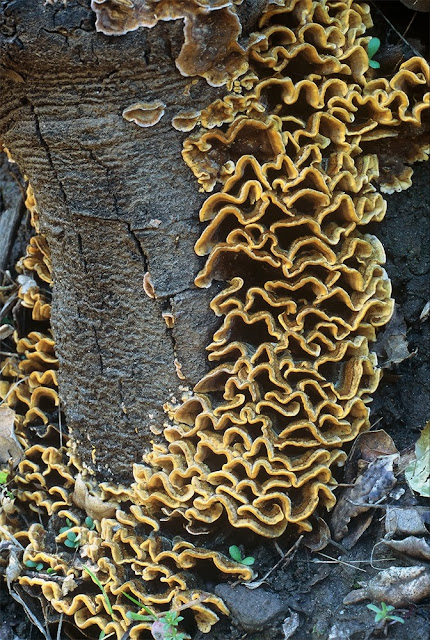Mushroom Season in Cuyamaca Woods
Now that we've had our first significant rain of the season, there might be some interesting fungi popping up here and there in the Woods.
Even though our precipitation later in the season will often be in the form of snow, when the snow melts after the storms move on, the moisture often translates into mushroom and other fungal fruiting bodies in the landscape.
I have been interested in mushrooms and fungi for many years, not because I have any interest in consuming them, but because they make fascinating photographic subjects. And they don't move, or try to run away -- always a plus when it comes to nature photography! And by the way, even if you do enjoy a little chopped mushroom in your salad or accompanying certain main dishes, it is highly advised that you do not collect wild local mushrooms for this purpose, unless you have a deep understanding of the classification and properties of wild mushrooms. As the saying goes: "There are old mushroom hunters, and there are bold mushroom hunters -- but there are no old, bold mushroom hunters!"
A little background biology might help explain the strange, ephemeral nature of mushrooms. When you see a mushroom on a log or popping out of the ground, it is just a temporary reproductive structure (or "fruiting body"), created by the more permanent mycelium of the fungus. A mycelium is a mass of string-like strands of cells (hyphae) which feed by releasing digestive enzymes into the surroundings and then absorbing the nutrients formed by the digestion. When it gets wet, this is a good time for the stationary mycelium to create a structure that can release mobile spores into the surroundings. The spores may blow away, and if they land in a favorable (usually damp) spot, grow into a new mycelium (and a new individual). That is why mushrooms only last a few days, and then seem to melt into a gooey mess when spore production is done.
One of the more spectacular local fungi is the Western Giant Puffball (Calvatia booniana), which appears almost every year on my property. It can reach a diameter of 8 -10 inches and reputedly is good to eat when young and tender (but I don't recommend it!).
 |
Western Giant Puffball,
Calvatia booniana
|
Another large, eye-catching
local fungus is the Jack-O-Lantern (Omphalotus olivascens) an
orange-tan mushroom that reputedly can be bioluminescent. I have attempted to
observe this bioluminescence after dark but have never seen it firsthand.
 |
| Jack-O-Lantern, Mountain Meadow Road |
Another common local fungus is the Turkey Tail (Trametes
versicolor), a shelf fungus. After rain,
the Turkey Tails growing here and there, typically on dead wood, will seem to
come to life, showing colors and texture not seen when they are dry and
desiccated.
 |
| Turkey Tail, Sandy Creek Road |
I have encountered quite a few other photogenic fungi up
here in the Woods in the years that we have lived here, and although the lower
foothill areas are usually much richer in colorful or attractive mushrooms in
winter, we're still not too bad, if you take the time to look.
 |
| Coprinus sp., Mountain Meadow Road |
 |
| Unidentified shelf fungus, Engineers Road. |






















































